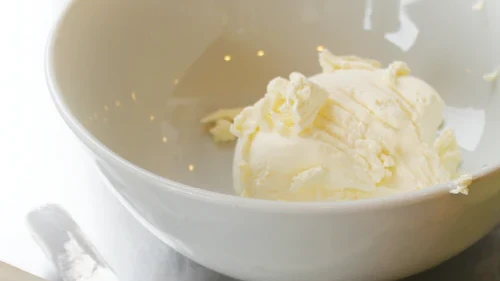Your Cart is Empty

How to make cream cheese dripped from homemade yogurt
Barb Hodgens
Barb Hodgens loves to cook with alternative, healthy whole food ingredients, with a focus on gut health. Barb has overcome her own gut health issues through healthy eating. Share your ideas, comments and photos at the end of this post :)
STEP BY STEP DRIPPED YOGURT, CURD / LABNE
Do you feel seriously indulgent if you eat cream cheese? Especially sweetened, laden on a cake or made into a dessert? Well, you needn't when it's cream cheese, (otherwise known as yogurt cheese, curd or labne) dripped from homemade yogurt. It’s very easy to make at home, the process is simple and has one ingredient, yogurt! Any yogurt can be dripped, however, no store-bought yogurt will have the probiotic goodness that matches the homemade kind.
Dripping yogurt is the process of separating the whey (yogurt liquid) from yogurt solids. The process reduces the volume which increases the richness, making it an ideal cultured product for dips, spreads, desserts and frosting. Anything you could do with a store-bought cream cheese you can do with this!

Like many traditional food preparation techniques, yogurt cream cheese takes some forward planning. It requires a minimum 6-8 hours to drip - overnight is perfect. You can strain yogurt in a nut bag, colander lined with cheese or muslin cloth or gather up the ends and hang it to drain. When the whey has dripped out of yogurt you are left with a delicious cultured, creamy, white, cheese. If you want a soft, spreadable consistency, keep the drip at the shorter end. The longer you leave it the drier it becomes. After 24 hours the cheese will be quite crumbly. Creamy, spreadable or crumbly, it is brimming with health-giving probiotic goodness.
Homemade yogurt cream cheese is high in protein and lower in sugar and carbohydrates than yogurt, making it a good choice for diabetics and people on low carb diets.
If you’re making yogurt cream cheese to use in a recipe, start with more homemade yogurt than the recipe requires as the volume will be reduced by more than half, depending on how long you strain it. If a recipe calls for half a cup of cream cheese, you might want to start with 1 ½ - 2 cups of yogurt to be safe. It’s not an exact science, but it’s best to strain more to make sure you end up with the amount required.

DON'T DISCARD THE WHEY
There are many uses for whey Save the whey that collects in the bowl; it’s filled with nutrients, can be used as a milk substitute in baked goods or smoothies. Pour it into a jar and store in the fridge.



How to make cream cheese dripped from homemade yogurt
Luvele
Rated 5.0 stars by 3 users
Do you feel seriously indulgent if you eat cream cheese? Especially sweetened, laden on a cake or made into a dessert? Well, you needn't when it's cream cheese, (otherwise known as yogurt cheese, curd or labne) dripped fromhomemade yogurt.
Ingredients
-
2 cups (or more) of cows milk yoghurt or raw milk yogurt or goats milk yogurt
Directions
There are many ways to strain yogurt and you may need to get creative with your set up. In hot weather, it is best to let the yogurt strain in the fridge.
Spread your cloth on a clean surface or over a dinner plate (to catch the escaping whey) and spoon the yogurt onto the centre of the cloth.Draw up the four corners of the cloth and gently scrunch together to form a pouch. Whey may begin to drip through immediately. Do not squeeze as this blocks the cloth and slows down the natural separation and drip process.
Use a rubber band to tie the cloth.
- Push the wooden spoon through the rubber band knot and place it across the jug like a rafter, allowing the yogurt pouch to hang down from it inside the jug. Make sure the bundle isn’t hanging down to far – you want it clear of the whey that will collect at the bottom.
When it has stopped dripping you can unravel your bundle and place the cheese in an airtight container in the fridge. It’s ready to eat as is or it can be transformed into some other culinary fancy. The possibilities are endless.
In the refrigerator cream cheese keeps for about 1 month and whey for up to 6 months.
ENJOY THESE RECIPES USING CREAM CHEESEVanilla cream cheese icing plus 5 fun variations
Raspberry jelly cheesecake made from homemade yogurt
Festive probiotic yogurt cheese domes
Homemade Goat milk Labne Or purchase our comprehensive Yogurt Handbook for loads more recipes
Recipe Video
PIN THIS RECIPE

BUY YOUR STARTER CULTURE HERE


How to make cream cheese dripped from homemade yogurt
STEP BY STEP DRIPPED YOGURT, CURD / LABNE
Do you feel seriously indulgent if you eat cream cheese? Especially sweetened, laden on a cake or made into a dessert? Well, you needn't when it's cream cheese, (otherwise known as yogurt cheese, curd or labne) dripped from homemade yogurt. It’s very easy to make at home, the process is simple and has one ingredient, yogurt! Any yogurt can be dripped, however, no store-bought yogurt will have the probiotic goodness that matches the homemade kind.
Dripping yogurt is the process of separating the whey (yogurt liquid) from yogurt solids. The process reduces the volume which increases the richness, making it an ideal cultured product for dips, spreads, desserts and frosting. Anything you could do with a store-bought cream cheese you can do with this!

Like many traditional food preparation techniques, yogurt cream cheese takes some forward planning. It requires a minimum 6-8 hours to drip - overnight is perfect. You can strain yogurt in a nut bag, colander lined with cheese or muslin cloth or gather up the ends and hang it to drain. When the whey has dripped out of yogurt you are left with a delicious cultured, creamy, white, cheese. If you want a soft, spreadable consistency, keep the drip at the shorter end. The longer you leave it the drier it becomes. After 24 hours the cheese will be quite crumbly. Creamy, spreadable or crumbly, it is brimming with health-giving probiotic goodness.
Homemade yogurt cream cheese is high in protein and lower in sugar and carbohydrates than yogurt, making it a good choice for diabetics and people on low carb diets.
If you’re making yogurt cream cheese to use in a recipe, start with more homemade yogurt than the recipe requires as the volume will be reduced by more than half, depending on how long you strain it. If a recipe calls for half a cup of cream cheese, you might want to start with 1 ½ - 2 cups of yogurt to be safe. It’s not an exact science, but it’s best to strain more to make sure you end up with the amount required.

DON'T DISCARD THE WHEY
There are many uses for whey Save the whey that collects in the bowl; it’s filled with nutrients, can be used as a milk substitute in baked goods or smoothies. Pour it into a jar and store in the fridge.


PIN THIS RECIPE

BUY YOUR STARTER CULTURE HERE


Subscribe
Sign up to get the latest on sales, new releases and more …

